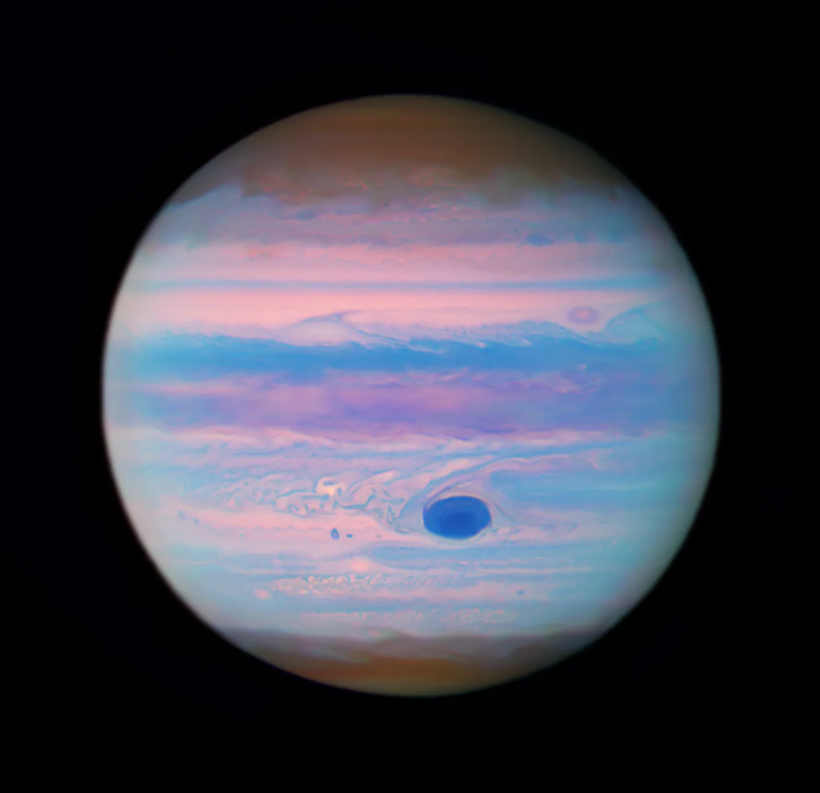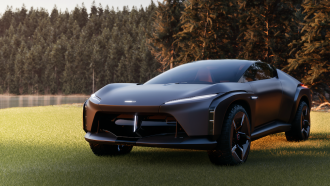NASA's Hubble Space Telescope has recently unveiled a unique view of Jupiter, presenting the gas giant in a striking composite of ultraviolet wavelengths.
This release coincides with Jupiter's opposition, a celestial event occurring when the planet and the sun lie on opposite sides of the sky.
NASA's Hubble Space Telescope Probes 'Great Red Spot' in Jupiter
NASA's Hubble Space Telescope Probes 'Great Red Spot' in Jupiter
The image features the renowned "Great Red Spot," a colossal storm on Jupiter's surface. Interestingly, while the storm typically appears red to human observers, in this ultraviolet representation, it appears darker due to the absorption of light by high-altitude haze particles at these wavelengths.
Additionally, NASA explained that the reddish polar hazes exhibit a slightly lower absorption of light, likely due to variations in particle properties or altitude.

The data employed to craft this ultraviolet image stems from a Hubble proposal to investigate Jupiter's enigmatic superstorm system.
Researchers aim to use the Hubble data to map out the intricate three-dimensional cloud structures within Jupiter's atmosphere, particularly in deep water clouds.
Hubble has a rich history of scrutinizing the outer planets, from studying the impacts of Comet Shoemaker-Levy 9 to delving into Jupiter's turbulent storms.
With its extensive operational tenure and distinctive vantage point, Hubble continues to furnish astronomers with invaluable insights into the evolving dynamics of this planet.
The telescope's proficiency in observing the ultraviolet spectrum equips astronomers to explore the realm of short, high-energy wavelengths of light that lie beyond the range of human vision.
NASA noted that ultraviolet light serves as a revealing window into a multitude of cosmic phenomena, including emissions from the youngest and hottest stars within nearby galaxies, as well as providing data on the composition, densities, and temperatures of interstellar material and shedding light on the evolutionary trajectories of galaxies.
It must be noted that this is a false-color image, as ultraviolet light remains invisible to the human eye. To render the image, distinct ultraviolet filters were used, each corresponding to a specific color in the visible spectrum. The assigned colors for this image are Blue (F225W), Green (F275W), and Red (F343N).
Read Also: NASA's Hubble Space Telescope Catches Spiral Galaxy in Patches of Bright Pink, Dark Red
Webb Catches a Cosmic Crab
In related news, NASA's James Webb Space Telescope has directed its infrared gaze towards the Crab Nebula, a supernova remnant situated 6,500 light-years away in the constellation Taurus.
Initially documented by astronomers in 1054 CE, the Crab Nebula has since captivated scientists, serving as a pivotal subject for comprehending the dynamics, behavior, and aftermath of supernovae.
Webb's infrared scan unveils a distinct cage-like structure of ethereal gaseous strands painted in red-orange hues. Moreover, within the central zones, Webb exposes the emission from dust grains, displaying shades of yellow-white and green for the first time.
The inner workings of the Crab Nebula come into sharper focus and exhibit heightened accuracy within the infrared spectrum captured by Webb. Specifically, Webb illuminates the phenomenon known as synchrotron radiation: the emission originating from charged particles, such as electrons, swiftly traversing along magnetic field lines.
Related Article: NASA Hubble Discovers Saturn's Ring System Heats Planet's Atmosphere-A Never-Before-Seen Phenomenon!










